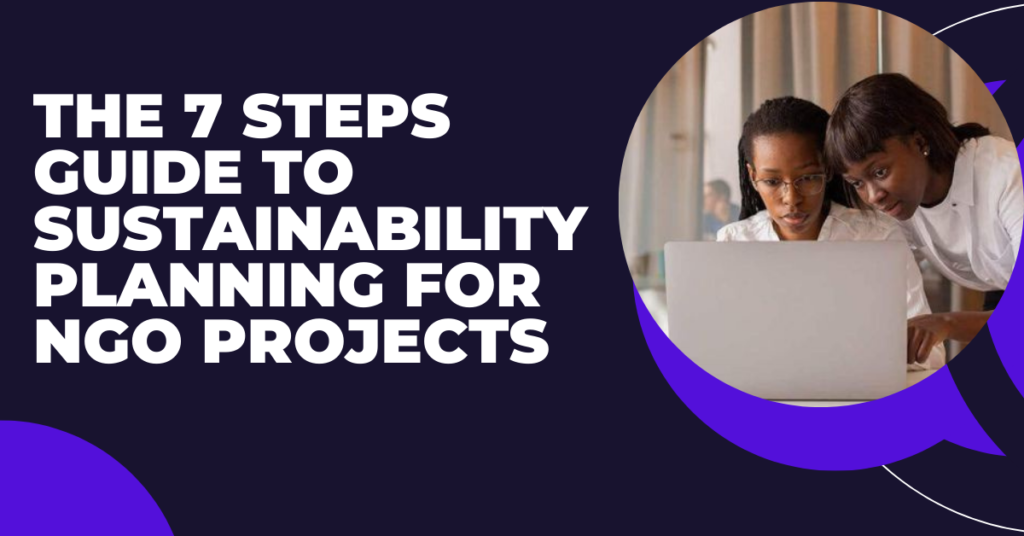
Menu
Facebook-f
Twitter
Google-plus-g
The 7 Steps to Sustainability Planning for NGO Projects
Sustainability planning is essential for ensuring that your NGO project continues to make a positive impact long after its initial phase. It involves creating strategies to maintain the project’s activities, outcomes, and benefits over the long term. Effective sustainability planning helps your project endure, adapt, and thrive in changing circumstances. In this guide, I’ll walk you through the steps of creating a sustainability plan, using straightforward language and practical tips.
Step 1: Define Your Project’s Sustainability Goals
Identify Long-Term Objectives:
Before you start planning for sustainability, clarify what you want to achieve in the long run. Consider the following questions:
- What are the core outcomes you want to maintain? For example, if your project provides educational resources, your goal might be to ensure continued access to these resources.
- Who will benefit from your project in the future? Identify the target groups or communities that will continue to benefit from your project’s impact.
Set Specific Goals:
Translate your long-term objectives into specific, measurable goals. These goals should reflect what you want to achieve in terms of project continuity and impact.
Example:
If your project aims to improve literacy rates in a community, a sustainability goal might be to establish a local library and training program that can operate independently after the project ends.
Step 2: Develop a Sustainability Strategy
Identify Key Components:
To create a robust sustainability strategy, consider the following components:
- Financial Sustainability: Plan how you will secure ongoing funding. This might include diversifying income sources, such as grants, donations, and fundraising events.
- Organizational Capacity: Ensure your organization has the necessary skills, resources, and infrastructure to continue running the project. This could involve training staff, strengthening partnerships, and improving organizational systems.
- Community Engagement: Engage the community and stakeholders to build support and ownership. Involve local leaders, beneficiaries, and partners in the project’s planning and implementation.
Create a Strategy Plan:
Outline how you will address each component of your sustainability strategy. Include action steps, responsible parties, and timelines.
Example Strategy Plan:
- Financial Sustainability:
- Secure three new grants by the end of the year.
- Develop a monthly donor program to ensure steady income.
- Organizational Capacity:
- Train two staff members in grant writing and fundraising.
- Strengthen partnerships with local organizations.
- Community Engagement:
- Host quarterly community meetings to gather feedback and build support.
- Involve community members in project activities and decision-making.
Step 3: Build Partnerships and Collaborations
Identify Potential Partners:
Look for organizations, businesses, or individuals who share your mission and could help support your project. Potential partners might include:
- Local Businesses: They may provide financial support, in-kind donations, or volunteer services.
- Other NGOs: Partnering with similar organizations can offer shared resources and expertise.
- Government Agencies: They can offer grants, policy support, or additional resources.
Develop Partnerships:
Reach out to potential partners and establish formal agreements or memorandums of understanding (MOUs). Clearly define the roles and responsibilities of each partner to ensure effective collaboration.
Example:
Partner with a local business for in-kind donations of supplies and a local NGO for shared expertise and resources.
Step 4: Create a Funding Plan
Diversify Funding Sources:
Relying on a single source of funding can be risky. Develop a diverse funding plan to reduce dependency on one source and increase financial stability. Consider:
- Grants: Apply for multiple grants from different sources.
- Donations: Encourage individual and corporate donations.
- Fundraising Events: Organize events to raise money and awareness.
Develop a Fundraising Strategy:
Outline specific actions to secure and manage funds. This might include:
- Grant Writing: Prepare and submit grant proposals.
- Donor Engagement: Develop strategies to engage and retain donors.
- Event Planning: Plan and execute fundraising events.
Example:
Create a yearly fundraising calendar with planned events and campaigns, and establish relationships with potential major donors.
Step 5: Strengthen Organizational Capacity
Assess Organizational Needs:
Evaluate your organization’s current capacity and identify areas for improvement. This might include:
- Staff Training: Ensure staff have the necessary skills and knowledge.
- Infrastructure: Invest in technology, systems, and processes that support project operations.
Build Capacity:
Invest in training, technology, and resources that will enhance your organization’s ability to sustain the project. Consider:
- Staff Development: Offer professional development opportunities and training programs.
- Systems Improvement: Upgrade technology and implement efficient processes.
Example:
Provide grant writing and financial management training for staff and upgrade your project management software.
Step 6: Engage the Community
Build Local Ownership:
For a project to be sustainable, it must be supported by the community it serves. Engage community members to build ownership and ensure their ongoing involvement. Strategies include:
- Community Involvement: Involve local leaders and beneficiaries in planning and decision-making.
- Feedback Mechanisms: Create channels for ongoing feedback and input from the community.
Develop Engagement Strategies:
Plan activities that foster community involvement and support. This might include:
- Workshops and Meetings: Hold regular meetings to update the community and gather feedback.
- Volunteer Programs: Encourage community members to volunteer and participate in project activities.
Example:
Organize community workshops to discuss project goals and gather input, and establish a volunteer program to involve local residents in project activities.
Step 7: Monitor and Evaluate Sustainability Efforts
Track Progress:
Regularly monitor and evaluate your sustainability efforts to ensure they are effective. This involves:
- Setting Metrics: Define indicators to measure the success of your sustainability strategies.
- Collecting Data: Gather data on financial performance, community engagement, and organizational capacity.
Adjust Strategies:
Based on your evaluation, make necessary adjustments to your sustainability plan. This might involve refining your funding strategies, improving community engagement, or strengthening organizational capacity.
Example:
Evaluate your funding sources and adjust your fundraising strategy if needed, based on performance data and feedback.
Conclusion
Sustainability planning is about ensuring that your NGO project continues to create positive impacts over the long term. By defining clear sustainability goals, developing a robust strategy, building partnerships, diversifying funding, strengthening organizational capacity, engaging the community, and regularly evaluating your efforts, you can enhance the long-term success and impact of your project. Remember, sustainability is an ongoing process, and being proactive in your planning will help ensure that your project thrives long after its initial phase.
Address List
-
Makerere Hill Road, Ham Towers -
+256-703947778 -
info@professionalwriters.shop
Social Networks
Links List
Professional Writers Inc.
Turning Ideas Into Reality
Business Plan Writing Training [Free]





